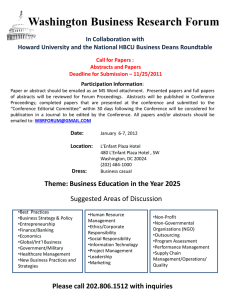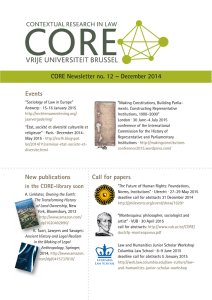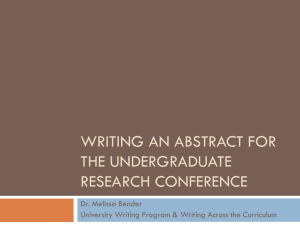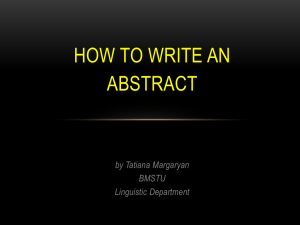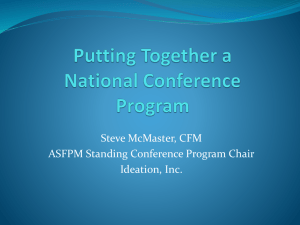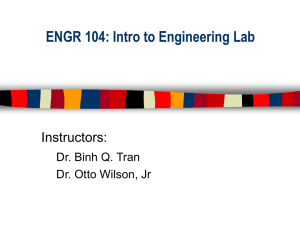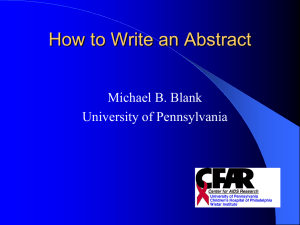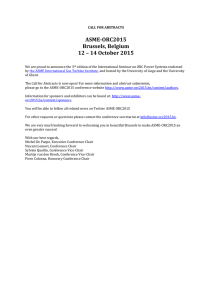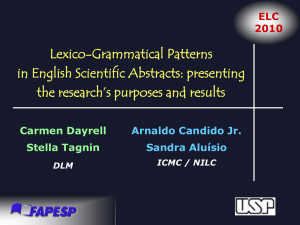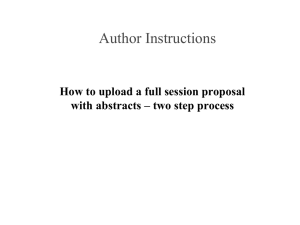How to Prepare an Abstract
advertisement
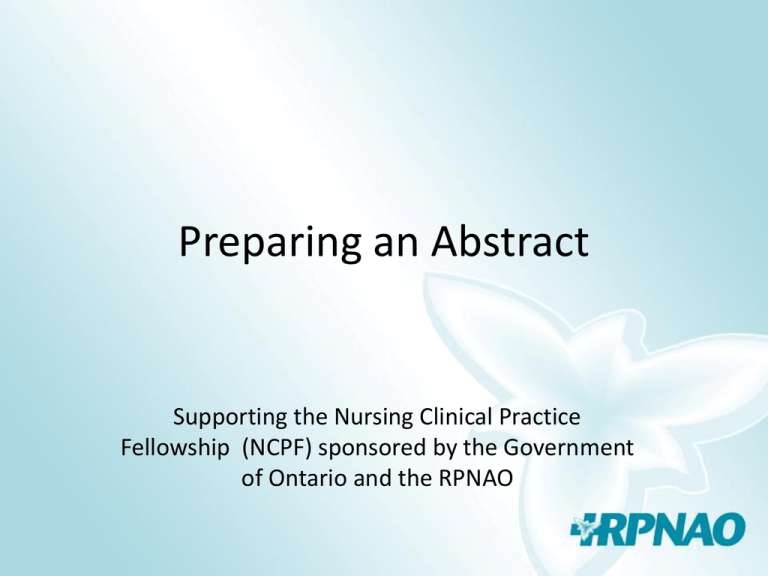
Preparing an Abstract Supporting the Nursing Clinical Practice Fellowship (NCPF) sponsored by the Government of Ontario and the RPNAO What is an Abstract ? • An abstract is a statement of your intended presentation to a conference planning committee • Abstracts provides the committee with an overview of your topic in 500 words or less Abstracts Include: Title: How to Zip Line Safely Author(s): May Fall & Sue Flew The key points should include: – Focus: research/non-research – Significance of the presentation – Purpose/outline of the presentation – Conclusion or results that are significant – Audience this presentation is relevant – How the topic relates to the conference theme What is a “Call for Abstracts” ? • An invitation to professionals to share their knowledge and expertise at a conference • Conference organizers advertise for presentation submissions relevant to the conference theme or specialty • The abstract can be submitted for: – Poster Presentation – Oral Presentation – OR Both How do I write an abstract? Three important concepts that will assist in writing an abstract 1. Review the conference theme or specialty – Enhancing Geriatrics Care (theme) – Geriatric Foot Care (specialty) – Sub-themes/focus (education) 2. The topic framework: – two types: research or non-research 3. Consider the type of audience – Nursing – Interdisciplinary Choosing a topic Review the purpose of the conference- the theme or specialty will guide your abstract. The stated themes from the “Call for Abstracts” should be integrated into your abstract Clinical Educational Theme Administrative Research Determine the focus or sub-theme of your presentation Types of Abstracts Research Guidelines – Background or significance of problem – Purpose of investigation – Methods used to collect and analyze data – Results of study – Conclusion, including implications for practice Types of Abstracts Non-Research Guidelines – Statement of the purpose of the project – Description of the issue/program, technique that will be presented – Summary of the major conclusions researched – Description of the significance and implications for practice Researching the Topic • Topic research is required to both support the significance of your presentation and to demonstrate it is evidencebased • Use current and accurate references – Scholarly journal articles, published texts, research research results – Support your work with current research • within the last 5 years – Avoid newspaper and magazine articles – Use Caution with internet sites • Canadian Celiac Association • Glenda’s Great Gluten Diet for Celiac Disease Determine Abstract Content • Read other abstracts that are relevant- a previous conference syllabus will provide successful examples • Abstract title- it must attract interest • Use the research or non-research guideline to list the relevance, key concepts and outcomes of your topic • First draft of the abstract must be completed a minimum of 1 month prior to deadline to accommodate review Developing the Abstract Divide the abstract information into three main paragraphs: Paragraph One Statement of Significance: Why this topic is important Establish the relevance to conference theme Paragraph Two Purpose/Outline: Two to three key points that outline your presentation This presentation will… Paragraph Three Conclusion: Summarize outcomes Results of significance Relevance to audience Reviewing the Abstract Once you are finished writing the abstract it’s time to edit, edit, edit….most abstracts require more that one draft First Review or Self Review STEP 1! Review the “Call for Abstracts” guideline to ensure • • • • • the required content the correct outline (research/non-research) Content reads effortlessly Major points are clear (numbering works well) Continuity between the purpose and summation Reviewing the Abstract Second Review or Peer Review ROUND 2!! • Complete a peer review (select a peer or peers with relevant knowledge of the topic and abstract submissions • - Provide the “Call for Abstracts” with your abstract • Expect the reviewer(s) to provide feedback • Refine your abstract from the feedback and remove unnecessary content (remember the word limit) • Ensure adequate time for turn around (1 week) Final Review • Abstracts should have a final review by someone familiar with writing abstracts to ensure: • Clarity • Flow • Unnecessary content is deleted • Ensure adequate time for turn around (1 week) Formatting the Abstract Once you have edited your abstract it is important to review the “Call for Abstract” guidelines to comply with the required format – – – – 12 pt Arial, Tahoma or Times New Roman Word or described program Parenthesis after full word for first time abbreviation use: electrocardiogram (ECG) – Use of correct template and template requirements for submission (fax/electronic submission) – Word count to ensure that no more that the specified “Call for Abstract” word count has been exceeded maximum Submitting the Abstract • Use a submission checklist if provided • Submit prior to the deadline • Ensure all the requested information is included • Discuss conference with your supervisor for support (poster cost), scheduling requests and funding suggestions Confirmation Notification • Confirmation of abstract acceptance for a presentation will only be sent to the first listed presenter once the selection committee has conferred • Inform your supervisor of abstract acceptance to confirm scheduling requests and funding suggestions • The presenter is responsible to complete and sign a “Presentation Acceptance and Release and Authorization” form by the acceptance deadline via fax (always keep a copy of the fax confirmation) Abstract accepted Responsibilities • Presenters must pay for registration • Presenters are responsible for all expenses incurred for presentation – Handouts – Poster publishing costs – Travel – Accommodation References • “Abstracts 101” (2004). Retrieved June 9, 2006 from Canadian Association of Nephrology Nurses and Technologists. Web site: http://www.cannt.ca • Canadian Journal of Cardiovascular Nursing Abstract Submission Guidelines (2002).
